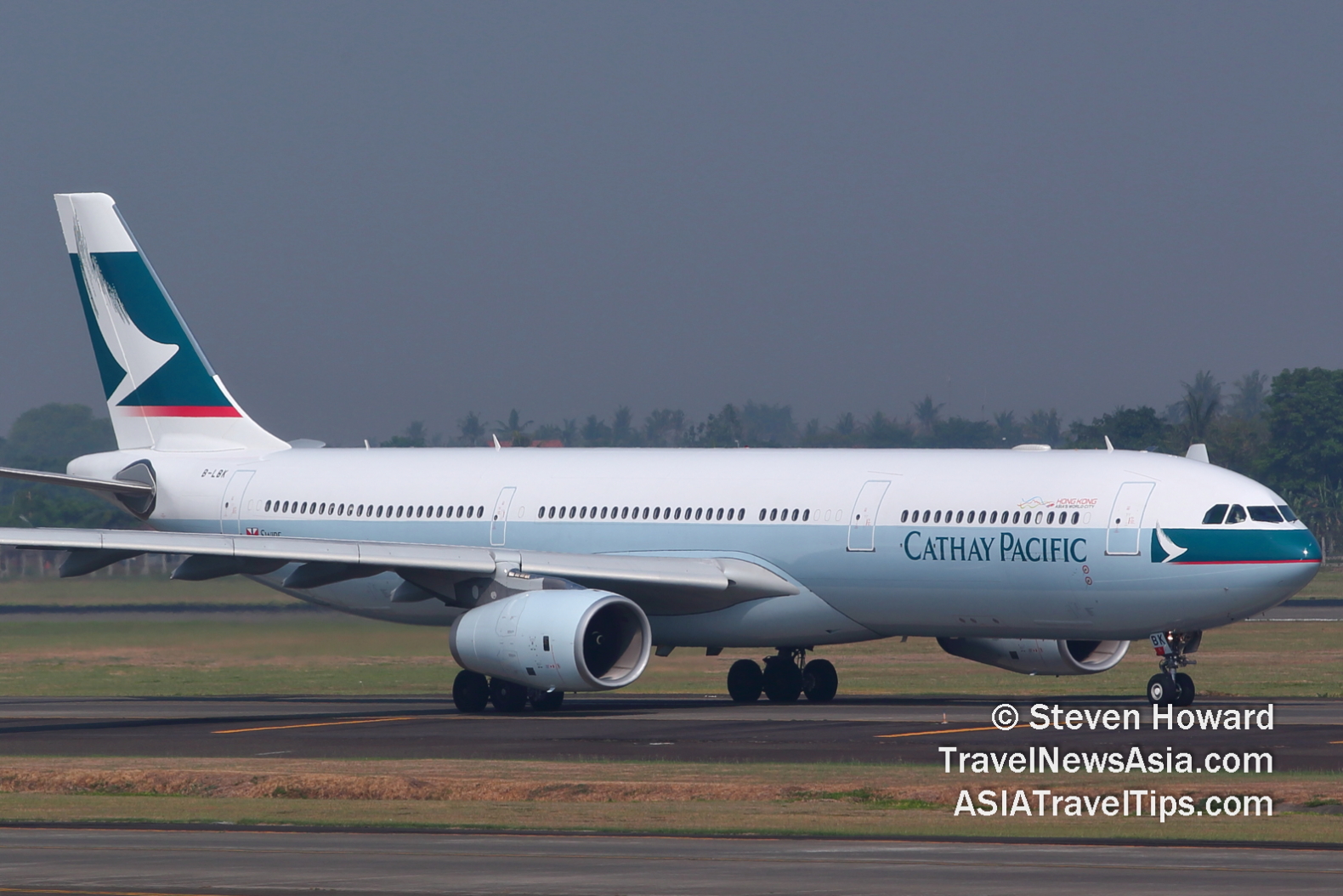|
(18 August 2022, 11:13 +07)
Cathay Pacific carried 219,746 passengers in
July 2022, an increase of 306.2% compared to July 2021, though a
93.3% decrease when compared to the pre-pandemic level in July 2019.
The month�s revenue passenger kilometres (RPKs)
increased 348.4% year-on-year, down 89.4% on July
2019.
Passenger load factor increased by 44.7 percentage points to
73.3%, while capacity, measured in available seat kilometres
(ASKs), increased by 74.6% year-on-year, a decrease of 87.6%
compared with July 2019.
In the first seven months of 2022,
the number of passengers carried increased by 162.8% against a
6.3% decrease in capacity and a 189.8% increase in RPKs, as
compared to the same period for 2021.

Cathay Pacific A330 reg: B-LBK. Picture by Steven Howard of TravelNewsAsia.com
�We continued to add more passenger flight
capacity in July in light of the Hong Kong SAR Government�s
progressive adjustments to travel and quarantine restrictions.
Capacity increased by 24% compared to June, although it remained
low at 12.4% of the pre-pandemic level. Passenger volume increased
to an average of over 7,000 per day. Meanwhile, passenger load
factor reached 73.3% � the highest it�s been since the start of
the pandemic,� said Chief Customer and Commercial Officer, Ronald
Lam. �The additional capacity we were able to operate
provided enhanced connectivity options for our customers
transiting through the Hong Kong hub, with demand from the Chinese
Mainland to Australia and the US particularly robust. We also saw
strong demand on our UK routes, especially from students returning
to Hong Kong. As many of these flights were full, some of this
student traffic shifted to our other European gateways such as
Amsterdam and Frankfurt. Meanwhile, we were able to resume
carrying passengers to Fuzhou, Nanjing and Wuhan in the Chinese
Mainland again following adjustments to local capacity
restrictions.�
The airline carried 100,714 tonnes of cargo last
month, a decrease of 17.2% compared to July 2021, and a 40.7%
decrease compared with the same period in 2019.
The month�s cargo
revenue tonne kilometres (RFTKs) decreased 27.5% year-on-year, down 42.6% compared to July 2019.
The cargo load factor
decreased by 10.8 percentage points to 71%, while capacity,
measured in available cargo tonne kilometres (AFTKs), was down by
16.4% year-on-year, a fall of 48.9% on July 2019.
In the
first seven months of 2022, the tonnage decreased by 6.6% against
a 28.3% drop in capacity and a 34.2% decrease in RFTKs, as
compared to the same period for 2021.
�Cargo demand remained flat in many of our key
markets in July as we entered the traditionally quieter summer
months for air cargo. Tonnage decreased month on month across most
markets, reflecting reduced cargo flight capacity due to weather
related cancellations as well as ongoing operational restrictions
which impacted the July schedule. The major impact of these
challenges was seen on our Indian and the Americas routes, whilst
capacity on our European routes grew marginally,� said Mr Lam. �Overall, our cargo volumes dipped by about 4%
month-on-month against an approximately 7% decrease in capacity.
We operated 51% of our pre-pandemic cargo flight capacity last
month. Meanwhile, load factor was 71%.�
Looking Ahead
�Looking ahead on the travel side, the latest
adjustments to quarantine arrangements for passengers arriving in
Hong Kong are expected to have a positive impact on inbound
traffic as well as leisure travel among Hong Kong residents.
Student traffic to the US and UK is also expected to provide our
travel business with a strong boost in August and September.
However, our ability to add more passenger flight capacity will
remain limited unless the restrictions on our aircrew are lifted,�
Mr Lam said. �Regarding cargo, we expect to operate a full
freighter schedule in August and going forward, complemented by
regional cargo-only passenger flights and more belly capacity
provided by our additional passenger services. However, long-haul
cargo-only passenger flights will be limited. The situation
involving cross-border trucking services between Shenzhen and Hong
Kong remains uncertain, and we will continue to monitor the
situation closely and adapt accordingly. We are cautiously
optimistic about a solid seasonal winter peak season, although
this is anticipated to be less pronounced than the one we
experienced in 2021 in light of the current global economic
environment.�
Latest
exclusive video interviews: Future of Air Travel -
Interview with Sumesh Patel, President of SITA Asia Pacific; Miss
International Queen 2024 (MIQ 2024) - Interview with Alisa
Phanthusak, MD, Tiffany's Show Pattaya, Thailand; 16
HD Video Interviews from Routes Europe 2024 in Aarhus, Denmark;
9 HD Video Interviews from Routes Asia 2024 in Langkawi, Malaysia;
Standard to Open Residences in Hua Hin and Phuket, Thailand; Video
Interview with Amar Lalvani, Executive Chairman;
9 Exclusive Video Interviews
from ASEAN Tourism Forum
2024
in Vientiane, Laos;
8 NTO Press Conferences from ASEAN Tourism Forum 2024 in
Vientiane, Laos;
13 HD Video Interviews from World Travel
Market 2023 in London, England;
5 HD Video Interviews from APG World Connect 2023 in Monaco, France;
and
15 HD Video Interviews from Routes World 2023 in Istanbul, Türkiye.
|
Headlines: |
|
|
